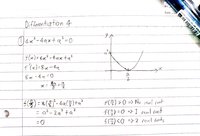Ok so, i still understand about the concept of finding the roots whether it is 2 or 1 real, or complex root.
Since the root is a point at where the line touch the x-axis/or literally the x-intersection (right?)
Coincident will do.
But i still can't understand why the equation above can have like 3 state of roots (where f(a/2) < 0 has roots,= 0 no roots, etc etc)
Which equation? You have given us notes that deal with more than one equation.
Let's do this equation, 4x
2 - 4ax + a^2.
One way:
[MATH]d = (-4a)^2 - 4(4)(a^2) = 16a^2 - 16a^2 = 0.[/MATH]
We used the discriminant. Notice that the discriminant = 0 for every real value of a.
Another way:
[MATH]f(x) = 4x^2 - 4ax + a^2 \implies f'(x) = 8x - 4a \text { and } f''(x) = 8.[/MATH]
Because the leading coefficient of the quadratic is positive, the graph of this function is concave up, right?
Now if the value of the quadratic is positive at its minimum point, then it will never touch the x-axis, right? So there will be no real root. If the value of the quadratic is negative at its minimum point, it is below the x-axis and so must cross the x-axis twice and there will be two roots. Does that make sense? And if the value of the function at its minimum point is zero, that is the only point at which it touches the x-axis, and there will be just one real root.
Is any of that obscure?
Now in principle, the number of x-intercepts may be dependent on a parameter. (We know it isn't in this case because we used the discriminant, but if we did not take the discriminant approach, we would not know this yet .)
[MATH]f'(x) = 0 \implies 8x = 4a \implies x = 0.5a.[/MATH]
So the value of x where this function is a minimum is at 0.5a. What is the value of the function at that value.
[MATH]4(0.5a)^2 - 4a(0.5a) + a^2 = 4 * 0.25a^2 - 4 * 0.5a^2 + a^2 = a^2 - 2a^2 + a^2 = 0. [/MATH]
So, the derivative approach tells us that the value of the function at its minimum point will equal zero no matter what value a is. This of course is exactly what we found using the discriminant approach.
So for what values of a will there be no real roots? Two real roots? One real root?
Now when we get to polynomials of degree higher than 4, there is nothing equivalent to the discriminant method so then we need to use the differentiation method.
Not being a mind reader, I shall not try to determine what your teacher was saying. I have enough difficulty understanding what I say myself. But I am more than willing to try to answer any questions you may have about what I have written.








